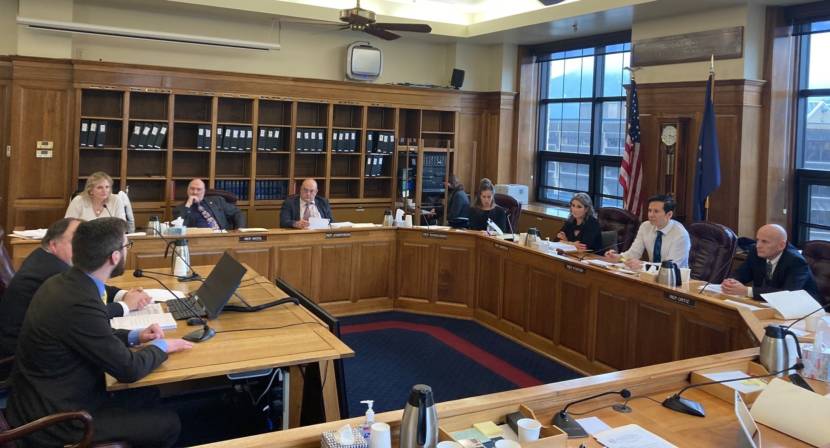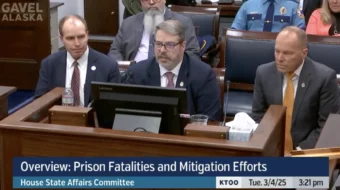
The Alaska House of Representatives is scheduled to debate the state budget this week. One of the biggest differences over the budget is not over dollars and cents — it’s over what name to call the money that will be sent to Alaskans later this year. The disagreement is over the message lawmakers want to send.
This year’s budget is unlike any the Legislature has debated since the price of oil fell in 2014. Oil prices are back up, and so is state revenue. That allows for some big-ticket spending proposals in the version of the budget the House Finance Committee passed last week:
- $1.2 billion to fund public education for the following year, a year ahead of time;
- $57 million to increase school funding per student;
- $472 million to pay off the last of the oil and gas tax credits the state has been paying off the last several years; and
- $395 million set aside to rebuild the Higher Education Investment Fund, used to pay for university scholarships and medical education.
Under both Gov. Mike Dunleavy’s budget proposal and the one the House Finance Committee passed last week, Alaskans would receive roughly $2,550 in payments from the state.
Dunleavy has said that’s the amount permanent fund dividends should be this year. He also wants to pay more than $1,200 in additional dividends, based on the difference between the PFD he proposed last year and the actual size of the dividend Alaskans received.
Members of the House majority caucus have proposed a 2022 dividend that’s half of what Dunleavy proposed. They’re calling the other half of the payment an energy relief check.
Palmer Republican Rep. DeLena Johnson, a minority-caucus member, sponsored an amendment that would have paid the entire amount as dividends. She said that would be closer to the current formula. And she said the Legislature comes up with excuses each year to not follow the formula.
“We could say the stock market is volatile,” she said. “We can say all kinds of what-ifs as why we don’t want to pay it. But the fact is that we have a statute. We’ve struggled with the statute. We’ve talked about the statute. I mean, this has brought the Legislature to a standstill — a standstill — over the last four years.”
Anchorage Democratic Rep. Andy Josephson, a member of the majority, opposed the amendment.
“My main problem with this is that it fundamentally says, ‘Let’s forget the lessons of 2014 to 2021, as if that part of history didn’t happen,’” he said.
During those years, paying larger dividends would have required some combination of spending cuts, new taxes, or larger draws from state savings.
So Josephson is concerned with the message describing the entire payment as a dividend would send — and that it would set up Alaskans’ expectations that dividends would be that size every year.
Nikiski Republican Rep. Ben Carpenter supported the amendment. He said setting PFDs at the lower amount also would send a message that the Legislature wants to spend more of the annual draw from the permanent fund on government.
“We’re communicating our intention to do something with the permanent fund earnings,” he said.
The two proposals also reflect a split over the formula setting the dividend amount, which hasn’t been followed since 2015.
Neither proposal would follow the current formula, which would pay a dividend of roughly $4,200.
Dunleavy’s dividend proposal is based on using half of the money the state plans to draw from permanent fund earnings on the PFD. That’s the same as what dividends would be under a formula he supports including in the state constitution.
The House Finance Committee budget includes a PFD that is equal to what dividends would be if the state were to use one-quarter of the annual draw from permanent fund earnings on dividends.
Anchorage Republican Rep. Sara Rasmussen predicted that Alaskans will understand the payments they receive this year as dividends, regardless of what they’re called.
“I don’t think that, because we’re calling it something different, the public will recognize that this is two separate payments,” she said. “We can speak about it, but the majority of the public doesn’t tune in to the news regularly.”
She compared the energy relief check proposal to similar payments the state paid in 2008. She said that as long as Alaskans receive the money at the same time, it will appear to be a PFD.
Fairbanks Democratic Rep. Adam Wool disagreed. He said the 2008 payments did not set up public expectations that dividends would be higher from then on, in part because the state government said it was responding to high energy prices. And he said that can happen again.
“It definitely was noted as a separate amount, due to high oil,” he said. “And I’d like to keep it that way.”
Fairbanks Republican Rep. Bart LeBon also said he’s concerned about the precedent of calling the entire payment a dividend.
“I mean, it wasn’t too many months ago in this building, we were talking, ‘broad-based tax’ like it was something that had to happen sooner than later and the only question to be answered was, ‘Is it a sales or income?’” he said.
LeBon said the talk of taxes stopped this year. But he predicted it could come back in the future if the state pays higher dividends.
The House Finance Committee failed to adopt the amendment, which means that half of the payment is still called an energy relief check.
The timing of when the budget debate will begin is uncertain. On Monday and Tuesday, the House didn’t hold a full floor session, after some members refused to wear face masks. House Speaker Louise Stutes reinstituted a mask requirement on the floor after at least one representative and multiple staff members tested positive for COVID-19.


